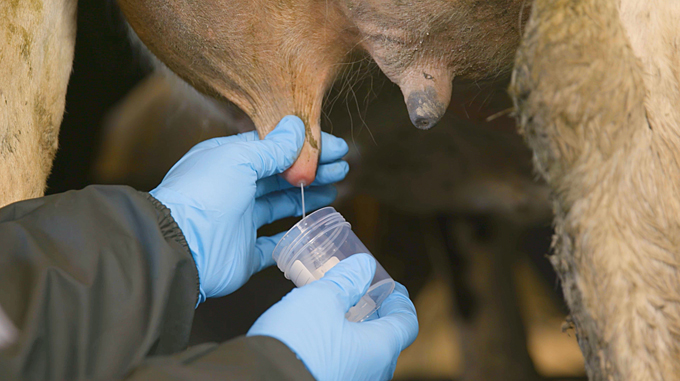UNDERSTANDING MASTITIS
Finding mastitis as soon as possible will help you maintain milk quality and animal well-being on your farm.
Mastitis can be categorised as either: Clinical and Subclinical:
- Clinical: milk and/or quarter appears abnormal (clots, flakes, swollen, etc)
- Subclinical: milk and quarter appears normal, but somatic cell count (SCC) is elevated (>150,000 cells/mL)
Explore more information on mastitis in cattle
IDENTIFYING CLINICAL MASTITIS:
- Inspect/feel quarters, and strip to examine the milk of:
- Slow/mildly lame cows
- Cows which seem kicky or sensitive at cups-on
- Cows with swollen, painful, or red quarters
- Cows with debris hanging from their quarters at cups-off
- All colostrum cows at every milking
- Continue to strip the milkers on a regular schedule, as dictated by your bulk milk somatic cell count, udder hygiene and the history of mastitis on your farm
- Check the milk filter for clots and flakes after milking. This may tell you if a clinical case has gotten into the vat
Once you find a cow with clinical mastitis: Mark, Record, Separate, then Treat (MRS. T) her following your farms protocols. Watch our “Treat Mastitis” video to learn more. If you get mastitis milk on your gloves, clean or change them before carrying on with milking.
IDENTIFYING SUBCLINICAL MASTITIS:
- Herd test
- RMT individual cowsTo perform an RMT:
- Add equal parts milk and RMT solution to the appropriate well of a clean RMT paddle (one well corresponds to each quarter)
- Swirl the mixture for 5 seconds
- Grade the reaction (thickening or no thickening) straight away
- Any thickening of the mixture indicates a high quarter level SCC of at least 200,000 cells/mL

MILK CULTURING FOR MASTITIS DETECTION:
Milk culturing is another helpful tool to detect mastitis in cattle. Culturing the milk from many clinical and subclinical mastitis cases identifies which bacteria are responsible for infection. Over time, this can help you:
- Decide which treatments to use at different times of year
- Make three-quartering and culling decisions
- Improve mastitis prevention by giving you some clues about how mastitis behaves on your farm
To take a clean milk sample for bacterial culture: (NB. Do this prior to treating the cow)
- Clean and dry your gloves
- Thoroughly disinfect the teat end with a clean teat wipe or cotton ball soaked in meths. Allow it to dry
- Uncap a clean, unused sample pottle, without touching the lid to any dirty surface
- Hold the sample pottle and cap in one hand at a 45 degree angle to the end of the teat

- Direct 2-3 squirts of milk onto the ground, then direct several squirts (5-10 mL of milk) into the sample pottle
- Replace the lid quickly
- Label the pottle with the cow’s number, quarter and date the sample was collected
- Store the sample in the refrigerator if you can submit it to your vet for culturing within 24 hours, or in the freezer if you would like to submit it later
REFERENCES
- DairyNZ SmartSAMM. (2012). Lactation Technote 12: Use individual cow SCC for management decisions. www.dairynz.co.nz
- Dairy Team, University of Wisconsin Extension. (2011) California mastitis test (CMT). Retrieved from:
https://topmilk.msu.edu/-/media/assets/topmilk/docs/milk-quality-and-mastitis-tests–new/california-mastitis-test/cmt-article1.pdf - DeLaval. Do you know how to collect an aseptic milk sample? https://www.youtube.com/watch?v=7Sol-tBNVnQ
- DairyNZ SmartSAMM. (2012). Calving Technote 4: Rapidly find, record and treat clinical mastitis in recently calved cows. www.dairynz.co.nz
- DairyNZ SmartSAMM. (2012). Lactation Technote 10: Rapidly find, record and treat clinical cases. www.dairynz.co.nz
- DairyNZ SmartSAMM. (2012). Lactation Technote 11: Monitor bulk milk somatic cell count. www.dairynz.co.nz
FOR MORE:
Or find us on YouTube by searching: TopFarmersNZ
Or visit: msd-animal-health.co.nz

Top Farmers Know-How provides a reference library of industry best practice in some key animal health management areas including mastitis, dry off, calf health, BVD, salmonella and campylobacter. We know that farmers and vets are busy people, so we’ve created resources in different formats and in bite-sized chunks to make it more flexible and accessible.

